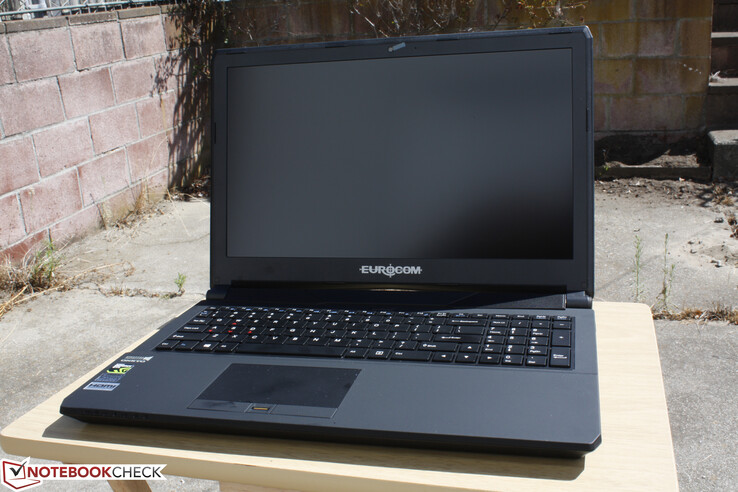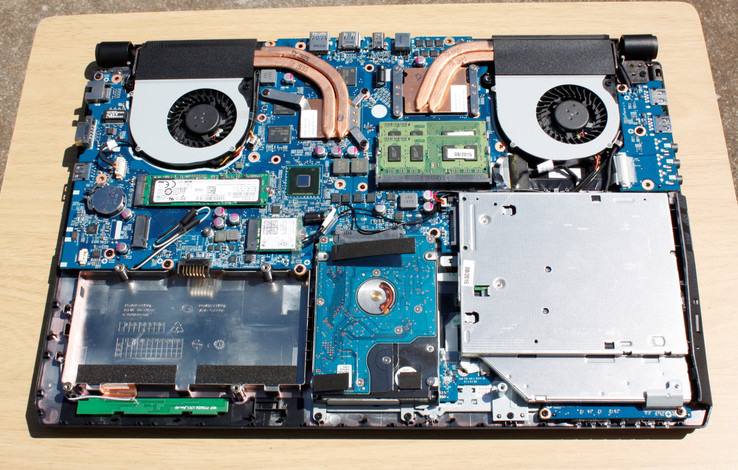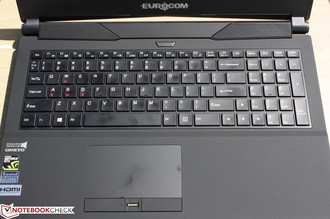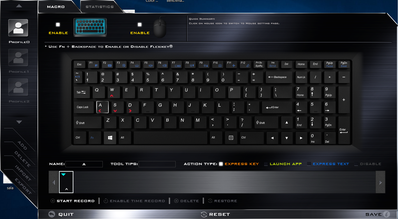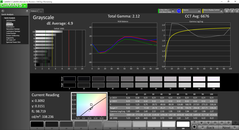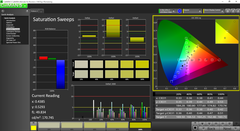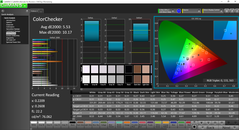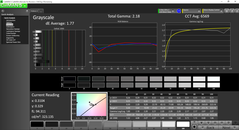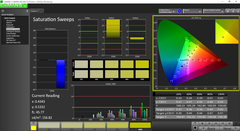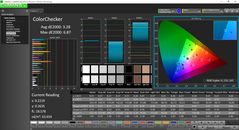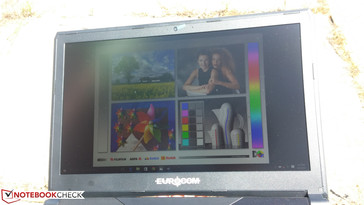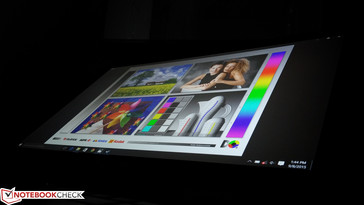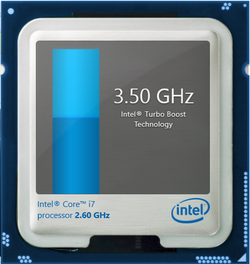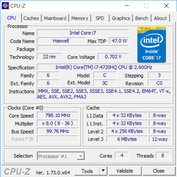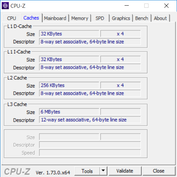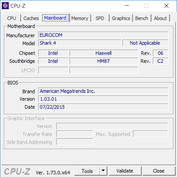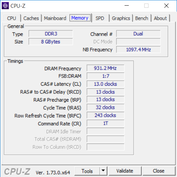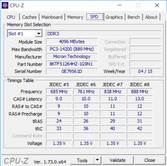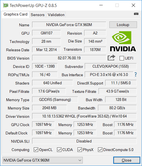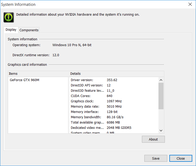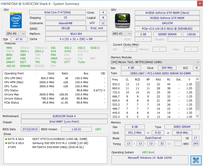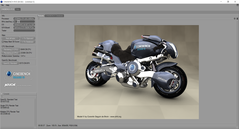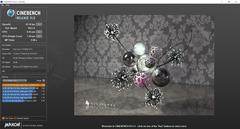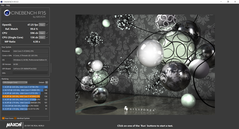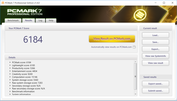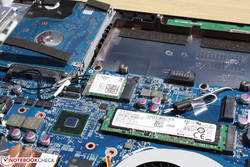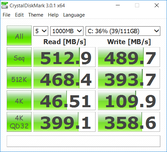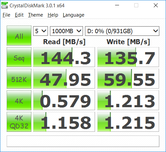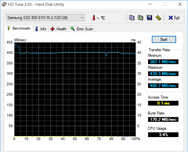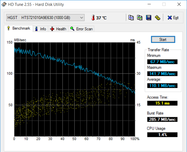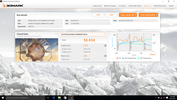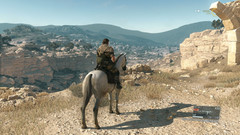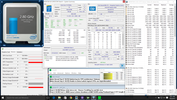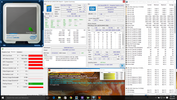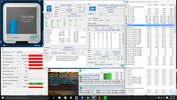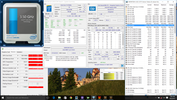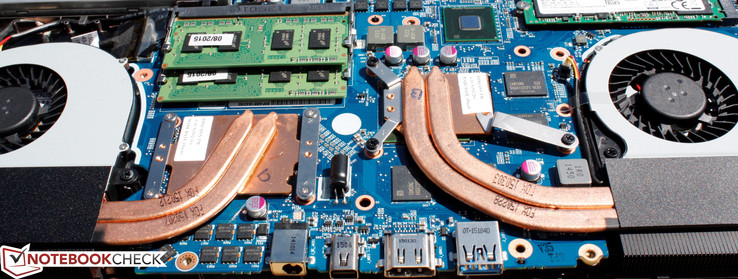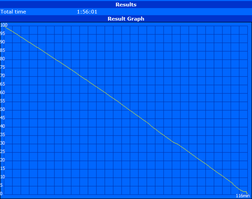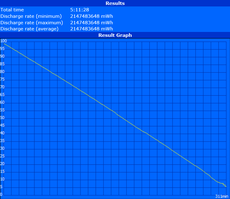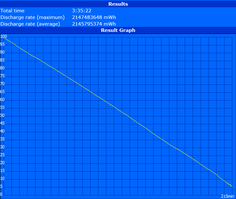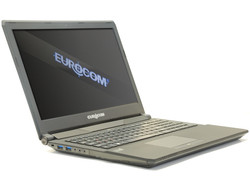Eurocom Shark 4 (Clevo N150SD) Notebook Review
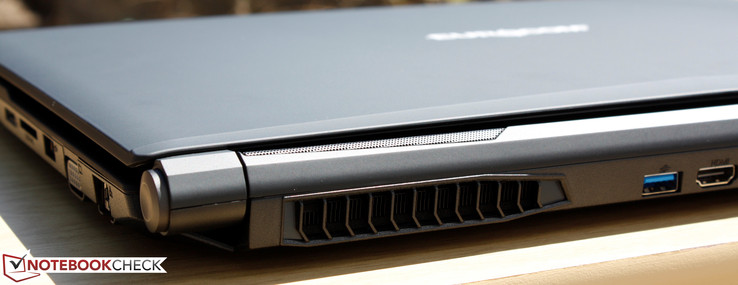
The ultraportable Shark series is now in its fourth generation with compelling reasons to be an alternative to the likes of the 15.6-inch Lenovo Y50, MSI GP62, MSI GE62, Acer Aspire V15, and other thin gaming notebooks from major manufacturers. Aside from the chassis update compared to the Shark 3, the Shark 4 integrates overlooked features for its category such as an optical drive, integrated SIM UMTS/HSPA+ support, and fingerprint reader. For this review, we'll see how the Eurocom compares to its closest aforementioned competitors.
The Shark 4 starts for as low as $900 USD with a fixed Core i7-4720HQ CPU and GTX 960M GPU across all configuration levels. Thus, users can save money by simply purchasing the lower-end configuration and upgrading the notebook over time due to its ease of accessibility.
Case
The matte black case looks lackluster compared to the brighter and more eccentrically designed competitors, but the Clevo N150SD barebones makes up for it with fantastic build quality around the base of the unit. Surfaces are rigid and both depressions and twists are almost non-existent. The lid, however, is weaker and more susceptible to damage. Resistance to twisting is low to the point where display colors can warp in response. Pushing down on the center of the outer lid is a bit too easy as well. The dual hinges are strong enough to prevent the lid from rocking when typing up to its maximum ~135-degree angle.
Texture-wise, the rubberized palm rests and outer lid feel luxurious and smooth to the touch. The major downside compared to common brushed aluminum surfaces is its tendency to attract and accumulate fingerprints much more noticeably. Cleaning is also made slightly more difficult. The edges, belly, and display bezel of the Shark 4 lack the rubberized surfaces and are instead roughly-textured ABS plastic.
As for size and weight, the Shark 4 is thicker and larger than more popular 15-inch gaming notebooks including the Acer Aspire V15 Nitro, Lenovo Y50, and Asus UX501. The MSI GP62/GE62 series and the Alienware 15 are thicker still, so the Shark 4 strikes a solid middle-ground while maintaining its superior base quality. Its weight of 2.5 kg is reflective of its larger size as this is a few hundred grams heavier than the aforementioned thinner notebooks, yet nowhere near as massive as the 3 kg Alienware 15.
Connectivity
A healthy selection of ports is available and the ports themselves are spread out evenly between the left, right, and rear edges. Aside from having three different video-out ports, the standout feature is the easily accessible SIM slot on the right edge. Most gaming notebooks lack SIM support completely and many business notebooks that do incorporate SIM support will typically have the slot inconveniently underneath the battery.
Missing ports include Thunderbolt and support for external desktop GPUs as featured on recent Alienware and MSI hardware.
Communication
3G and 4G LTE are supported via the integrated UMTS/HSPA+ M.2 3042 module. There is unfortunately no dedicated GPS module which would have really made the Shark 4 more attractive.
Standard WLAN and Bluetooth 4.0 are provided by a removable Intel Wireless-AC 7265 M.2 2230 module. We experienced no signal strength issues as the notebook was able to maintain a connection to a standard home network at 30 meters away with no obstacles in between.
Maintenance
About a dozen Philips screws must be removed to access the internal hardware. The difficult part is popping out the panel as the hinges are quite tight around the edges and corners. Snapping the panel back on can also be a challenge for the same reason.
Once off, users have direct access to both system fans, 2x SODIMM slots, PCIe x4 slot, M.2 slot, 2.5-inch HDD, optical drive, WLAN card, and other core components. Note that both the CPU and GPU are soldered onto the board.
Accessories
Included extras are a handy Windows 10 Drivers disc and a Media Suite disc. The power adapter is available in 120 W and 180 W options. We recommend the higher option to avoid any potential bottleneck and throttling issues when running very high or maximum loads.
Warranty
One-year coverage and tech support from Eurocom come standard with each new purchase. Users can extend the warranty to 2 or 3 years for $175 or $375, respectively.
Input Devices
Keyboard
The Chiclet keyboard (34.5 x 10.5 cm) provides satisfactory feedback when pressed with quiet keys and little clatter. On the other hand, travel is shallow and the force required to push each key is more than usual. However, this may be unfair to say as we had only recently published on the MSI GT80 and its signature mechanical Cherry keyboard. When compared to the Lenovo Y50, the keys on the Shark 4 wiggle less and feel more solid.
The full-size Arrow keys are appreciated especially when compared to the ones on the Acer Aspire V15 Nitro. However, gamers may be disappointed to see no dedicated Macro keys whereas these are common on most Gigabyte and Aorus notebooks. The FlexiKey software is the manufacturer's answer to Macro settings and key recording similar to those found on MSI, Razer, and Aorus notebooks. While easy to use, it feels more barebones and less flashy than its competitors. To nitpick even further, there is no physical light indicator for the Caps Lock key despite the keyboard itself having two levels of backlight brightness.
Touchpad
The smooth plastic surface area (10.75 x 6.25 cm) provides ample room for gestures and cursor control. The Elan software is able to recognize up to three fingers simultaneously. The bottom and right edges, however, are reserved for left-right and up-down scrolling, respectively, so the actual surface area for simple cursor movement is smaller than it appears. Disabling the edge scrolling feature does not seem to increase the size of the surface area for cursor control. Nonetheless, we experienced no latency or jumping issues during our time with the touchpad.
The dedicated mouse keys are textured similarly to the rubberized palm rests and are even quieter than the keyboard keys. In fact, these may be some of the quietest mouse keys we've seen as they are almost completely silent. Feedback suffers as a result and feels soft instead of firm with no solid "click". Travel is also quite deep and can be uncomfortable to use for extended periods since the user must push down farther on each key.
Display
The Shark 4 is equipped with a high quality 1080p panel with no touchscreen or higher resolution options. The lack of such features shouldn't really be an issue considering the target gaming audience and GTX 960M GPU. We have already seen that 2K resolutions or higher are a poor match with the 960M. Subjectively, our matte panel is crisp and free from screen-door artifacts and significant backlight bleeding. Colors also appear pure with no grainy aspects when displaying an all-white background. A very similar panel can be found on the recent Alienware 15 based on their matching LG LGD046F panel IDs.
Brightness and contrast are both higher than many competing 15.6-inch gaming notebooks including the Asus ZenBook UX501 and MSI GP62. Display quality is very close to that of the excellent Alienware 15.
| |||||||||||||||||||||||||
Brightness Distribution: 85 %
Center on Battery: 326.8 cd/m²
Contrast: 809:1 (Black: 0.404 cd/m²)
ΔE ColorChecker Calman: 5.53 | ∀{0.5-29.43 Ø4.78}
ΔE Greyscale Calman: 4.9 | ∀{0.09-98 Ø5}
87.8% sRGB (Argyll 1.6.3 3D)
57.8% AdobeRGB 1998 (Argyll 1.6.3 3D)
64% AdobeRGB 1998 (Argyll 3D)
87.7% sRGB (Argyll 3D)
68.4% Display P3 (Argyll 3D)
Gamma: 2.12
CCT: 6676 K
| Eurocom Shark 4 | MSI GP62-2QEi781FD | MSI GE62 2QD | Lenovo IdeaPad Y50-70-59441229 | Asus Zenbook Pro UX501JW-FI218H | Acer Aspire V 15 Nitro VN7-591G-77A9 | Alienware 15 | |
|---|---|---|---|---|---|---|---|
| Display | -20% | -1% | -37% | -24% | -3% | 1% | |
| Display P3 Coverage (%) | 68.4 | 50.8 -26% | 64.5 -6% | 39.51 -42% | 47.47 -31% | 66.9 -2% | 65.1 -5% |
| sRGB Coverage (%) | 87.7 | 73.6 -16% | 87 -1% | 59.4 -32% | 71.5 -18% | 84 -4% | 93.3 6% |
| AdobeRGB 1998 Coverage (%) | 64 | 52.4 -18% | 66.2 3% | 40.82 -36% | 49.05 -23% | 61.4 -4% | 66.2 3% |
| Response Times | |||||||
| Response Time Grey 50% / Grey 80% * (ms) | 43.2 ? | ||||||
| Response Time Black / White * (ms) | 27.2 ? | ||||||
| PWM Frequency (Hz) | |||||||
| Screen | -55% | -13% | -6% | -24% | -5% | 10% | |
| Brightness middle (cd/m²) | 326.8 | 274.8 -16% | 361 10% | 214 -35% | 302 -8% | 317 -3% | 308 -6% |
| Brightness (cd/m²) | 309 | 265 -14% | 345 12% | 227 -27% | 307 -1% | 319 3% | 292 -6% |
| Brightness Distribution (%) | 85 | 74 -13% | 88 4% | 79 -7% | 87 2% | 87 2% | 83 -2% |
| Black Level * (cd/m²) | 0.404 | 0.69 -71% | 0.646 -60% | 0.23 43% | 0.79 -96% | 0.46 -14% | 0.28 31% |
| Contrast (:1) | 809 | 398 -51% | 559 -31% | 930 15% | 382 -53% | 689 -15% | 1100 36% |
| Colorchecker dE 2000 * | 5.53 | 11.78 -113% | 5.3 4% | 4.9 11% | 5.4 2% | 5.79 -5% | 4.28 23% |
| Greyscale dE 2000 * | 4.9 | 13.81 -182% | 7 -43% | 4.13 16% | 5.99 -22% | 5.01 -2% | 4.54 7% |
| Gamma | 2.12 104% | 2.19 100% | 2.35 94% | 2.44 90% | 2.32 95% | 2.35 94% | 2.81 78% |
| CCT | 6676 97% | 15314 42% | 7168 91% | 7239 90% | 6670 97% | 7347 88% | 7497 87% |
| Color Space (Percent of AdobeRGB 1998) (%) | 57.8 | 47.8 -17% | 58.63 1% | 38 -34% | 45 -22% | 55 -5% | 60 4% |
| Color Space (Percent of sRGB) (%) | 87.8 | 73.5 -16% | 59 -33% | 71 -19% | 92.9 6% | ||
| Total Average (Program / Settings) | -38% /
-46% | -7% /
-10% | -22% /
-13% | -24% /
-24% | -4% /
-4% | 6% /
8% |
* ... smaller is better
The panel is capable of deep colors at almost 88 percent and 58 percent of AdobeRGB and sRGB standards, respectively. Gamut is notably better than the MSI GP62 and Lenovo Y50, both of which carry much poorer TN panels in comparison. When combined with its high contrast, games and movies look phenomenal on the Shark 4. Professional graphics artists may want at least 95 percent sRGB coverage, which is not available for the Shark series.
Further color analyses with an X-Rite spectrophotometer reveal relatively accurate colors out-of-the-box. However, we recommend a quick calibration as both grayscale and colors will become much more balanced. Colors will still become more inaccurate the higher the saturation level due to the imperfect sRGB coverage of the LG panel.
Outdoor visibility is poor under direct sunlight and acceptable under shade. The matte AH-IPS panel aids greatly in reducing glare if outdoor use is inevitable. The maximum brightness setting is recommended whenever possible to reduce eyestrain. Note that an IPS glossy panel is available from Eurocom as well if users prefer the glossy coating.
Viewing angles are excellent with no major shifts in colors or brightness when viewing from extreme angles.
Performance
The Core i7-4720HQ CPU and GTX 960M GPU are a common pairing for high-end gaming notebooks and are the only options available for the Shark 4 thus far. The Haswell CPU will idle at just 800 MHz if on the Power Saver profile, but can otherwise run up to 3.4 - 3.6 GHz with Turbo Boost. Similarly, the Nvidia GPU will idle at 135/405 MHz core/memory with a base clock rate of 1097 MHz + GPU Boost. Optimus is supported for additional power savings with the integrated Intel HD 4600 GPU.
Two SODIMM slots are available as opposed to four on most thicker Clevo barebones. LatencyMon shows no recurring latency spikes as expected from Eurocom notebooks where bloatware is kept to a minimum.
Processor
Raw CPU performance from the 2.6 GHz i7-4720HQ should be slightly above the 2.5 GHz i7-4710HQ and 2.4 GHz i7-4700HQ. In reality, however, any performance differences are hardly noticeable when gaming as the i7-4720HQ is already sufficiently powerful. CineBench benchmarks place our Shark 4 on essentially equal footing with the Aorus X3 and Clevo P150SM with the aforementioned slower CPUs. In fact, results are a bit lower than expected for our Shark 4 due to weaker Turbo Boost performance. The i7-4790K and i7-4940MX in the Eurocom P5 Pro and Eurocom X8, respectively, can provide double-digit percentage gains over our i7-4720HQ.
More benchmarks and comparisons on the Core i7-4720HQ can be found on our dedicated CPU page here.
| Cinebench R15 | |
| CPU Single 64Bit (sort by value) | |
| Eurocom Shark 4 | |
| Eurocom P5 Pro Extreme | |
| Eurocom X8 | |
| MSI GP62-2QEi781FD | |
| Clevo P150SM-A | |
| Aorus X3 Plus v3 | |
| CPU Multi 64Bit (sort by value) | |
| Eurocom Shark 4 | |
| Eurocom P5 Pro Extreme | |
| Eurocom X8 | |
| MSI GP62-2QEi781FD | |
| Clevo P150SM-A | |
| Aorus X3 Plus v3 | |
| Cinebench R10 | |
| Rendering Single CPUs 64Bit (sort by value) | |
| Eurocom Shark 4 | |
| Eurocom P5 Pro Extreme | |
| Eurocom X8 | |
| MSI GP62-2QEi781FD | |
| Clevo P150SM-A | |
| Aorus X3 Plus v3 | |
| Rendering Multiple CPUs 64Bit (sort by value) | |
| Eurocom Shark 4 | |
| Eurocom P5 Pro Extreme | |
| Eurocom X8 | |
| MSI GP62-2QEi781FD | |
| Clevo P150SM-A | |
| Aorus X3 Plus v3 | |
| Cinebench R11.5 | |
| CPU Single 64Bit (sort by value) | |
| Eurocom Shark 4 | |
| Eurocom P5 Pro Extreme | |
| Eurocom X8 | |
| MSI GP62-2QEi781FD | |
| Clevo P150SM-A | |
| Aorus X3 Plus v3 | |
| CPU Multi 64Bit (sort by value) | |
| Eurocom Shark 4 | |
| Eurocom P5 Pro Extreme | |
| Eurocom X8 | |
| MSI GP62-2QEi781FD | |
| Clevo P150SM-A | |
| Aorus X3 Plus v3 | |
| Super Pi Mod 1.5 XS 32M - 32M (sort by value) | |
| Eurocom Shark 4 | |
| Eurocom P5 Pro Extreme | |
| Eurocom X8 | |
| MSI GP62-2QEi781FD | |
| Clevo P150SM-A | |
| Aorus X3 Plus v3 | |
| wPrime 2.10 - 1024m (sort by value) | |
| Eurocom Shark 4 | |
| Eurocom P5 Pro Extreme | |
| Eurocom X8 | |
| MSI GP62-2QEi781FD | |
| Clevo P150SM-A | |
| Aorus X3 Plus v3 | |
* ... smaller is better
System Performance
PCMark scores are unsurprisingly very high as usual for Eurocom notebooks. The fast primary SSD is largely responsible for its fast system performance. Its PCMark 7 score of 6184 points is about 1000 points less than our current Eurocom P5 Pro Extreme record holder. Systems with RAID 0 SSDs will score higher, such as the MSI GE62.
Subjectively, Windows 10 responds quickly and without latency issues on our Shark 4. We experienced no peculiar software problems during our time with the test model.
| PCMark 7 Score | 6184 points | |
| PCMark 8 Home Score Accelerated v2 | 3683 points | |
| PCMark 8 Creative Score Accelerated v2 | 4526 points | |
| PCMark 8 Work Score Accelerated v2 | 4916 points | |
Help | ||
Storage Devices
Available storage ports include M.2 2280, M.2 PCIe x4 (2242), and a 2.5-inch SATA III bay that can accept both 7 mm and 9.5 mm drives. The optical drive can also be swapped for a fourth storage drive if desired. The Shark 4 is rather unique in that two types of M.2 slots are included, yet there is no official RAID support. Competing gaming notebooks tend to offer fewer internal storage options than the Eurocom.
Our specific test model is equipped with a primary 120 GB Samsung 850 EVO M.2 2280 SSD and a secondary 1 TB Hitachi Travelstar HDD. Read and write performances from the Samsung max out at around 500 MB/s as usual for most SSDs under SATA III speeds. It's worth noting that SSD performance is very consistent between read and write even for different block sizes. As for the secondary 7200 RPM HDD, HD Tune records an average transfer rate of just over 110 MB/s, which is very good for a mechanical drive. Most 7200 RPM and especially 5400 RPM drives tend to perform well below 100 MB/s under the same benchmark. For more benchmarks and comparisons, see our HDD/SSD list here.
Graphics Card
The Nvidia GTX 960M is a very popular high-end GPU for gaming notebooks as of 2015. We've benchmarked the GPU extensively and recommend checking out both our dedicated review and technical data page for more details and benchmarks.
For our Shark 4, synthetic GPU tests place our notebook roughly 20 to 30 percent over the GTX 950M in our MSI GP62 and about 40 to 60 percent behind the more powerful GTX 970M. The performance gap between the 950M and 960M compared to the 960M and 970M is thus noticeably smaller.
| 3DMark 06 Standard Score | 23733 points | |
| 3DMark 11 Performance | 5683 points | |
| 3DMark Ice Storm Standard Score | 84865 points | |
| 3DMark Cloud Gate Standard Score | 16414 points | |
| 3DMark Fire Strike Score | 4079 points | |
| 3DMark Fire Strike Extreme Score | 2040 points | |
Help | ||
| ComputeMark v2.1 | |
| 1024x600 Normal, QJuliaRayTrace (sort by value) | |
| Eurocom Shark 4 | |
| Eurocom P7 Pro | |
| Razer Blade 14 2015 | |
| MSI GP62-2QEi781FD | |
| Apple MacBook Pro Retina 15 inch 2015-05 | |
| 1024x600 Normal, Mandel Scalar (sort by value) | |
| Eurocom Shark 4 | |
| Eurocom P7 Pro | |
| Razer Blade 14 2015 | |
| MSI GP62-2QEi781FD | |
| Apple MacBook Pro Retina 15 inch 2015-05 | |
| 1024x600 Normal, Mandel Vector (sort by value) | |
| Eurocom Shark 4 | |
| Eurocom P7 Pro | |
| Razer Blade 14 2015 | |
| MSI GP62-2QEi781FD | |
| Apple MacBook Pro Retina 15 inch 2015-05 | |
| 1024x600 Normal, Fluid 2DTexArr (sort by value) | |
| Eurocom Shark 4 | |
| Eurocom P7 Pro | |
| Razer Blade 14 2015 | |
| MSI GP62-2QEi781FD | |
| Apple MacBook Pro Retina 15 inch 2015-05 | |
| 1024x600 Normal, Fluid 3DTex (sort by value) | |
| Eurocom Shark 4 | |
| Eurocom P7 Pro | |
| Razer Blade 14 2015 | |
| MSI GP62-2QEi781FD | |
| Apple MacBook Pro Retina 15 inch 2015-05 | |
| 1024x600 Normal, Score (sort by value) | |
| Eurocom Shark 4 | |
| Eurocom P7 Pro | |
| Razer Blade 14 2015 | |
| MSI GP62-2QEi781FD | |
| Apple MacBook Pro Retina 15 inch 2015-05 | |
Gaming Performance
Most intensive games as of 2015 are playable at native 1080p30 with settings on High or maximum. For higher resolutions or 60 FPS playback, however, we recommend moving up to the GTX 980M or a system with SLI 9xxM graphics.
Certain Nvidia-specific effects for Batman: Arkham Knight would cause an error when benchmarking as of its September 3 update. Given the title's infamous PC performance issues, this is perhaps unsurprising. Thus, our performance results on Ultra cannot be provided for this specific title.
| low | med. | high | ultra | |
|---|---|---|---|---|
| Sleeping Dogs (2012) | 93.8 | 24.7 | ||
| Tomb Raider (2013) | 116.5 | 53.5 | ||
| BioShock Infinite (2013) | 120.3 | 47.1 | ||
| Metro: Last Light (2013) | 59.5 | 32.3 | ||
| Thief (2014) | 56.1 | 28.8 | ||
| Middle-earth: Shadow of Mordor (2014) | 43.7 | 32.4 | ||
| F1 2014 (2014) | 109 | 88 | ||
| Batman: Arkham Knight (2015) | 60 | 33 | ||
| Metal Gear Solid V (2015) | 58.4 | 38.1 |
Stress Test
We stress the Shark 4 with synthetic benchmarks to identify for any throttling or stability issues.
First, with just Prime95 active, the Core i7-4720HQ plateaus at 2.8 GHz and a core temperature as high as 89 C. This multi-core Turbo Boost is 600 MHz slower than the rated 3.4 GHz maximum for the i7-4720HQ, which shows that the notebook exhibits weak Turbo Boost when under CPU-intensive tasks. Conversely, FurMark stress causes the Nvidia GPU to plateau at its base 1097 MHz clock rate and a core temperature of 85 C. The clock rate will occasionally drop further to 1084 MHz for brief periods, though such a small dip is largely insignificant.
Full system stress with both Prime95 and FurMark causes the CPU to drop to the 2.6 - 2.8 GHz range. Interestingly, GPU Boost remains active for steady GPU clock rates in the 1149 - 1162 MHz range. Fortunately, neither the CPU nor the GPU will throttle below their respective base clock rates. CPU and GPU temperatures plateau at 85 - 90 C and 87 C, respectively.
Unigine Heaven is a more accurate representation of gaming stress. Under these conditions, the CPU is able to maintain a higher Turbo Boost of 3.2 - 3.5 GHz while the GPU is able to maintain a higher GPU Boost of up to 1201 MHz. Stable core temperatures are also much lower for the CPU at 65 - 70 C and only slightly lower for the GPU at 85 C.
Running on battery power will throttle the CPU and GPU to just 1300 MHz and 300 MHz, respectively. A 3DMark 11 run on batteries returns Graphics and Physics scores of 1521 and 4492, respectively, versus 5440 and 7504 points when running on mains.
Emissions
System Noise
The cooling solution consists of a pair of identical 50 mm fans and four short heat pipes. The system is surprisingly small, especially when compared to the larger and much more powerful 15.6-inch Eurocom P5 Pro or even other ultrathin notebooks like the Gigabyte P35X or Asus G501.
Both system fans are always active even with the Quiet setting enabled through the pre-installed Fan Speed software. The fans are at 32 dB(A) at their quietest and can pulsate up to 33.5 dB(A) when browsing and multi-tasking on High Performance mode. Thus, we recommend browsing on Power Saver mode to avoid higher fan noise. The fans are also adaptive, meaning that only the CPU fan will increase in speed if the workload is CPU-intensive and similarly for the GPU fan.
Gaming will bump fan noise up to the 38 - 42 dB(A) range, which is common for regular-size 15-inch gaming notebooks. Ultrathin gaming models like the MSI GS60 or Gigabyte P35X can easily reach the high 40 dB(A) range under similar conditions, though they do house faster GPUs. Fan noise in the low 40 dB(A) range is mostly manageable when gaming. However, users will find that certain games where soft sounds are vital to gameplay are better played with headphones instead, such as Metal Gear Solid V.
Activating Maximum fan mode will raise fan noise to 48.5 dB(A). The feature is not necessary when gaming as it will not increase performance by any noticeable amount, but it will help in increasing CPU Turbo Boost just slightly during extreme loads.
Noise level
| Idle |
| 31.8 / 31.9 / 32 dB(A) |
| DVD |
| 35.2 / 38.2 dB(A) |
| Load |
| 38.2 / 48.5 dB(A) |
 | ||
30 dB silent 40 dB(A) audible 50 dB(A) loud |
||
min: | ||
Temperature
The short heat pipes mean higher surface temperatures will be concentrated on a smaller area. When idling, hot spots can already be felt near the bottom rear of the notebook closest to the heat pipes. Thus, certain quadrants will feel much cooler in comparison, such as the front areas of the notebook.
Maximum processing loads will cause the rear of the notebook to reach well over 50 C. Fortunately, this is concentrated on a very specific spot of the notebook that is far away from the palm rests. The WASD keys remain cool for gaming, though the center of the keyboard will become much warmer. The temperature gradient on the Shark 4 is indeed steeper compared to models like the MSI GE62 or Alienware 15 where temperature rise is spread more evenly throughout the notebook.
(-) The maximum temperature on the upper side is 48.8 °C / 120 F, compared to the average of 36.9 °C / 98 F, ranging from 21.1 to 71 °C for the class Multimedia.
(-) The bottom heats up to a maximum of 54 °C / 129 F, compared to the average of 39.2 °C / 103 F
(+) In idle usage, the average temperature for the upper side is 31.6 °C / 89 F, compared to the device average of 31.3 °C / 88 F.
(+) The palmrests and touchpad are cooler than skin temperature with a maximum of 29.8 °C / 85.6 F and are therefore cool to the touch.
(±) The average temperature of the palmrest area of similar devices was 28.7 °C / 83.7 F (-1.1 °C / -1.9 F).
Speakers
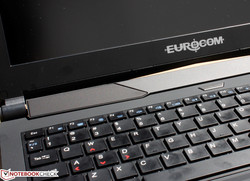
The redesigned stereo speakers now face diagonally and directly towards the user. There is no subwoofer, so music is noticeably lacking in bass. Thus, while maximum volume is sufficiently loud, sounds still feel weak without resorting to headphones or external speakers.
The Sound Blaster Cinema 2 software alleviates some of the shortcomings of the speakers with processing effects to enhance bass and voices alongside the usual Music, Gaming, and Movie preset settings. However, we still recommend headphones for extended video playback and gaming sessions.
Battery Life
Runtimes from the removable 62 Wh battery pack is good and slightly better than many competitors. Part of the reason is because of its higher capacity, especially when compared to the MSI GE and GP series. Users can expect 3 to 4 hours of constant Wi-Fi use on the Balanced profile with integrated graphics active.
Note that the battery pack requires a Philips screwdriver to remove instead of the familiar latch-and-lock on most other Clevo barebones.
| Eurocom Shark 4 62 Wh | MSI GP62-2QEi781FD 42 Wh | MSI GE62 2QD 51 Wh | Lenovo IdeaPad Y50-70-59441231 55 Wh | Asus Zenbook Pro UX501JW-FI218H 60 Wh | Acer Aspire V 15 Nitro VN7-591G-77A9 52.5 Wh | Alienware 15 92 Wh | |
|---|---|---|---|---|---|---|---|
| Battery runtime | -52% | -26% | -2% | -25% | 24% | 51% | |
| Reader / Idle (h) | 5.2 | 2.2 -58% | 4.6 -12% | 6.5 25% | 9.9 90% | 11.6 123% | |
| WiFi v1.3 (h) | 3.6 | 1.6 -56% | 2.7 -25% | 3.4 -6% | 2.7 -25% | ||
| Load (h) | 1.9 | 1.1 -42% | 1.1 -42% | 1.4 -26% | 1.1 -42% | 1.5 -21% | |
| WiFi (h) | 4.6 | 4.4 |
Pros
Cons
Verdict
The Shark 4 excels at providing excellent accessibility with a high quality accurate display, removable optical drive, and an unexpected SIM slot for 4G connectivity. The latter feature is what really separates the Shark 4 from other gaming notebooks, so users who know they can make use of it should definitely consider the Eurocom over other thin gaming notebooks. Even if users aren't interested in UMTS/HSPA+ connectivity, the base of the Shark 4 is stronger than the Lenovo Y50 and Asus G501 for a better sense of longevity, so there are still incentives in favor of Eurocom. The multiple storage bays only add to its advantages.
Notable downsides include its larger size, heavier weight, weaker lid, lack of RAID, and no dedicated Macro keys or subwoofer. Turbo Boost is also weaker than expected as the system is unable to maintain its maximum boost under synthetic stress. An upgradeable CPU or GPU would have been fantastic to really set the Shark 4 apart against other mainstream gaming notebooks, but users will have to make due with the GTX 960M as there are no other options.
Ultimately, the Shark 4 feels like a perfect middle-road solution between ultrathin gaming notebooks and much larger, thicker gaming notebooks.
Users who want a more well-made notebook than the Lenovo Y50 without the inflated size and cost of an Alienware will be satisfied with what the Shark 4 has to offer.
Eurocom Shark 4
- 09/11/2015 v4 (old)
Allen Ngo




